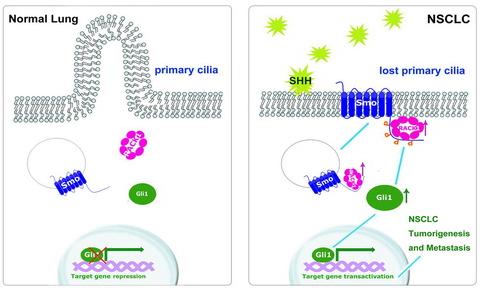RACK1 (Receptor of Activated Kinase 1) is a member of the β-propeller protein family, which functions as a scaffolding proteinto mediate protein–protein interaction andfacilitates tightly regulation of cellular function. Recently, RACK1 has been functionally associated with the development of various humancancers, but its role in non-small-cell lung cancer (NSCLC) is unexplored. NSCLC is an aggressive malignancy and a great effort has been made to improve the understanding of its molecular pathogenesis for discovering more effective therapeutic targets and diagnosis biomarkers. Malfunction of Hedgehog signaling pathway contributes to tumorigenesis, but the underlying mechanism in cancer remains unclear.
A team of researchers, led by Professor XIE Dong, at the Institute of Nutritional Sciences (INS), Shanghai Institutes for Biological Sciences, CAS, found that RACK1 promotes Non-small-cell lung cancer tumorigenicity through activating Sonic Hedgehog signaling pathway. They demonstrated that RACK1 is both a potential biomarker and a drug target in therapy of NSCLC and explored a novel mechanism for activating the SHH/GLI signaling pathway in cancer.
Dr. XIE and his colleagues found RACK1 was elevated in most NSCLC, and its expression level correlated with key pathological characteristics including tumor differentiation, stage and metastasis. Silencing RACK1 inhibited NSCLC tumorigenesis and metastasis. In addition, RACK1 expression correlated with elevated Gli1 levels in NSCLC, and Gli1 function was required for RACK1’s oncogenic effects. RACK1 was found to activate Gli1 transcription via interacting and activating Smoothened, a key positive regulator in the Sonic Hedgehog signaling pathway.
This research entitled "RACK1 Promotes Non-small-cell Lung Cancer Tumorigenicity through activating Sonic Hedgehog Signaling Pathway" was published in The Journal of Biological Chemistry on Jan. 19th, 2012.

Model of how RACK1 mediates activation of SHH/GLI signaling in NSCLC Cells
(Image by INS)

